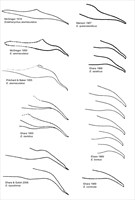Click on images to enlarge

Fig. 1. Various Eotetranychus species aedeagi, not to scale.
Material examined
non-types
Taxonomy
Subfamily Tetranychinae
Tribe Tetranychini
Common Name
six-spotted spider mite
Distribution
^^NOT PRESENT IN AUSTRALIA
(see Seeman et al. 2017 for more details)
China, Hawaii, India, Iraq, Japan, Korea, New Zealand, Taiwan, USA
Taxonomy Changes
Tetranychus 6-maculatus Riley 1890
Tetranychus sexmaculatus (Riley) Banks 1900
Eotetranychus sexmaculatus (Riley) Pritchard & Baker 1955
Hosts
>30 species including: Cinnamomum camphora, C. japonicum (Lauraceae), Citrus grandis, Cit. limon, *Cit. sinensis (Rutaceae), Ficus erecta, F. hispida, F. retusa (Moraceae), Fragaria sp. (Rosaceae), Hevea brasiliensis (Euphorbiaceae), Malus domestica (Rosaceae), Oxalis corniculata (Oxalidaceae), Persea americana (Lauraceae), Prunus mume, Pr. persica (Rosaceae), Psidium guajava (Myrtaceae), Rosa sp., Rubus sp. (Rosaceae), Vitis vinifera (Vitaceae)
Similar Taxa
See Figure 1 for details of aedeagi of the following species:
Eotetranychus asiaticus Ehara, E. boreus Ehara, E. cornicola Ehara
Eotetranychus kankitus Ehara, E. toyoshimai Ehara & Gotoh
Biology
Listed as a major pest of citrus (Gerson 2003).
McGregor (1919) states that this species is a serious pest of Citrus trees in Florida, with highest populations in February and March. The species forms restricted colonies, and causes a severe yellow blistering of the leaves, and when in high abundance causes serious defoliation of the affected trees.
References
Banks, N. (1900) The red spiders of the United States (Tetranychus and Stigmaeus). U.S. Dep. Agric. Div. Entomol. Tech. Ser. 8: 65-77
Bolland H.R., Gutierrez J., and Flechtmann C.H.W. (1998) World Catalogue of the Spider Mite Family (Acari: Tetranychidae). Brill Academic Publishers, Leiden, 392 pp.
Ehara, S. (1955) On two spider mites parasitic on Japanese Citrus. Annotations Zoologicae Japonenses 28: 178-182
Ehara, S. (1966) The tetranychoid mites of Okinawa Island (Acarina: Prostigmata). J. Fac. Sci. Hokkaido Univ. (Ser. 6) Zool. 16: 1-22
Ehara, S. (1969) Three spider mites of the genus Eotetranychus infesting fruit trees in Japan (Acarina: Tetranychidae). Appl. Ent. Zool. 4(1): 16-22
Ehara, S. (1973) Tetranychoid mites of fruit tree in Japan, with records of their host plants. In: Acaricide resistance in orchard mites in Japan. (Eds Iwata et al.). pp. 7-10.
Ehara, S. (1989) Four new species of spider mites (Acarina: Tetranychidae) from Japan. Proc. Japanese Soc. syst. Zool. 40: 28-38
Ehara, S. and Gotoh, T. (2006) Description of a new Eotetranychus from Japan with notes on two other species (Acari: Prostigmata: Tetranychidae). International Journal of Acarology 32(1): 39-44
+Froggatt, W.W. (1921) Orchard and garden mites. No. 2 - Spinning mites (Family Tetranychidae). Agricultural Gazette Sydney 32: 130-135
Manson, D.C.M. (1967) Mites of the families Tenuipalpidae and Tetranychidae intercepted entering New Zealand from overseas. New Zealand Journal of Science 10: 664-674
McGregor, E.A. (1919) The red spiders of America and a few European species likely to be introduced. Proceedings of the U.S. National Museum 56: 641-685
McGregor, E.A. (1950) Mites of the family Tetranychidae. The American Midland Naturalist 44: 257-420
Pritchard, A.E. and Baker, E.W. (1955) A revision of the spider mite family Tetranychidae. Pacific Coast Entomology Society Memoirs 2: 1-472
*Riley, C.V. (1890) The six-spotted spider mite of the orange (Tetranychus 6-maculatus, n. sp.). Insect Life 2: 225-226
Seeman, O.D., Beard, J.J., and Zhang, L. (2017) A new Australian species of Eotetranychus (Acari: Tetranychidae) from buck spinifex Triodia mitchelli (Poaceae), intraspecific variation in Eotetranychus, and the synonymy of Platytetranychus with Eotetranychus. Zootaxa 4324(3): 491-517
Notes
Bolland et al. (1998) lists +Froggatt (1921) as the first record of E. sexmaculatus in Australia; however, there is no record of this species being present in Australia in this paper. Therefore, it is assumed that, as no other reference exists, E. sexmaculatus is not present in Australia.
In addition, Seeman et al. (2017) show that the Australian specimens previously identified as E. sexmaculatus are in fact the native species E. queenslandicus. They also state that E. sexmaculatus is not present in Australia.
Eotetranychus sexmaculatus was first described in the USA from citrus, but there are issues with its true identity. There seem to be two different versions of the aedeagus for E. sexmaculatus presented as variations on a theme in various descriptions.
The first form of the aedeagus is represented by McGregor (1919: 659), who was the first to redescribe the species, and also to provide the first illustration of the aedeagus (Fig. 1). However, later McGregor (1950) presented a different illustration of the aedeagus, which represents the second form of the aedeagus in the literature.
In addition, there have been other species described that match either of these two forms (Fig. 1).
See Seeman et al. (2017) for further details.
Copyright © 2018. All rights reserved.